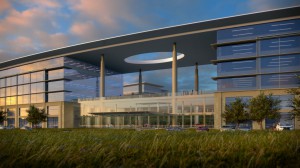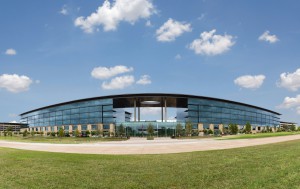
Toyota is ready take on all comers with the more than 3,000 employees from its old headquarters in California that moved to its new one in Texas.
Some 25 years ago, a book by three American professors, “The Machine That Changed the World,” underscored how Toyota modified the mass production system to gain an advantage over its rivals in the automotive industry around the world.
Toyota’s system of lean production, however, didn’t insulate the Japanese automaker from the impact of intensifying competition not only in the U.S. where Toyota’s system was emulated by rivals, but also in Asia and in Europe.
Toyota has had to fight off new challenges from Japanese rivals such as Nissan and Subaru even as its home market in Japan begins to shrink. South Korean automakers such as Kia and Hyundai have surged ahead in the closely watched J.D. Power & Associates Initial Quality Survey while American rivals have tightened their grip on the all-important truck market in the U.S.
At the same time, Volkswagen and General Motors have left Toyota in dust in China, the world’s largest automotive market, a development unforeseen in “The Machine That Changed the World.” At the same time, Toyota, like other automakers, is facing challenges from the tech industry that were unheard of only a decade ago and have lowered the once-formidable barriers to entry into the global auto industry.
However, Toyota remains a force to be reckoned with in the global industry, which the Japanese auto giant underscored last week with the dedication of its new billion-dollar North American headquarters in Plano, Texas.
The opening of the impressive new campus outside Dallas represented a huge transition that involved moving thousands of employees, blending cultures and creating an entirely new organization even as the company continued to build and sell a couple of million cars annually.
(Toyota has no plans to build a new plant in the U.S. Find out more, Click Here.)
“The opening of our new headquarters in Plano is an extraordinary next step in Toyota’s 60-year journey in the United States,” said Jim Lentz, CEO of Toyota in North America.
“With team members from four different companies together in one campus location, we believe this will inspire greater collaboration, innovation and faster decision making as we turn to and lead the future of mobility, all with an eye on our customers,” said Lentz, who emphasized the new headquarters will help prepare the company for the challenges of “the next 50 years.”
Toyota wanted to create an open modern office spaces that encourage discussion and collaboration and building consensus. The company could have gotten by with a less space, noted Carlos Soria, who is in charge of the facilities on Toyota’s new 100-acre headquarters campus north of Dallas.
“We also wanted every employee to have their own space where they could bring their family pictures,” he said.
At the same time half of the space in the seven building, covering more than 2.1 million-square feet of floor space are devoted to “diverse work spaces,” conferences rooms, classrooms and open areas geared for informal meetings. Even the spacious cafeteria, with seating for more than 800 includes inconspicuous spaces that can be used for meals by work teams from throughout the headquarters complex.
Other dining areas create informal spaces that mimic a neighborhood Starbucks that can be used by Toyota employees. There is also a gym complete with a climbing wall and a pharmacy and clinic.
“Our new campus has fun, unexpected, and even playful features that reflect our commitment to be a world-class leader in innovation with state-of-the-art facilities and cutting-edge technologies,” said Doug Beebe, general manager of real estate and facilities for Toyota Motor North America.
(Click Here for the details about Toyota putting its old California HQ up for sale.)

Jim Lentz, Toyota's top North American executive, said the new Texas-based headquarters will have the company ready to face the challenges of the next 50 years.
“It also is a great example of Toyota’s commitment to environmental sustainability,” he added. Solar panels built onto the roof of the adjacent parking garages generate 30% of the energy needed on the site and the other 70% will come from other renewable sources, primarily wind power.
Toyota’s commitment to renewable energy on the Plano, Texas, is something of a symbol of the different cultures and attitudes that prevailing cultures.
Lentz, who was instrumental in moving Toyota to Texas from California, tends to avoid talk of a culture clash. Toyota, after all, had flourished in Southern California, perhaps the world’s most vibrant automotive market, with its diverse population, flourishing connections to the arts and the entertainment industry and its powerful environmental movement.
Plano, on the other, hand could only be described as “Deep Red” in the words of Duncan Webb, a commissioner in Collin County, Texas, where Plano and new Toyota headquarters is located.
However, Dallas, even though it is two hours further away from Japan, is at the center of steadily expanding business community and also is closer to Toyota’s North American manufacturing base in the middle of the U.S., which now encompasses a growing technical center Michigan as well as factories in Indiana, Kentucky, West Virginia, Mississippi, Alabama and Texas and is easily accessible from the Dallas-Fort Worth Airport, one of the nation’s largest and busiest hubs for airlines operating in North America.
But more than 1,000 Toyota employees elected to stay in California and retire or look for other jobs. Word from inside the company is that dozens of other employees could leave the company during the next two years once they have collected all of the relocation benefits provided by Toyota.
Nonetheless, Toyota is counting on the energy unlocked by its organizational changes and put in motion in the new headquarters to give the company a lift in the years to come and hews closer to the philosophy of “The Machine That Changed The World.”
“There came a point that I think that Akio Toyoda looked at all this and said ‘You know this might not be the most efficient way to run our business,” said Lentz, noting before the move to Texas was sent in motion back in 2013, the company operated in separate silos with their staffs and objectives.
(Toyota settling into new Texas headquarters. Click Here for the story.)
The move to Texas, which will be complete in December, opened the door for creating “One Toyota,” he said, with one unique culture, capable of dealing with all kinds of future challenges.

